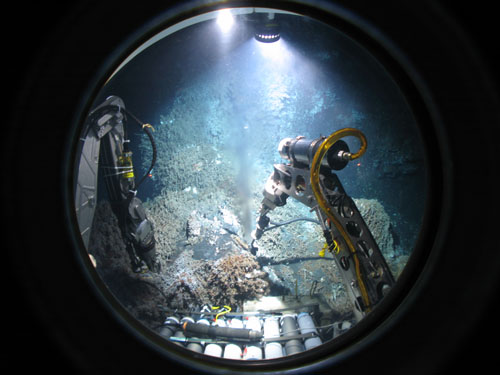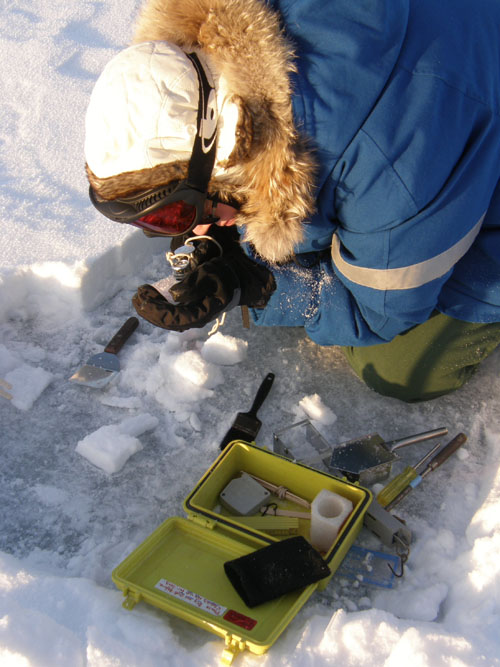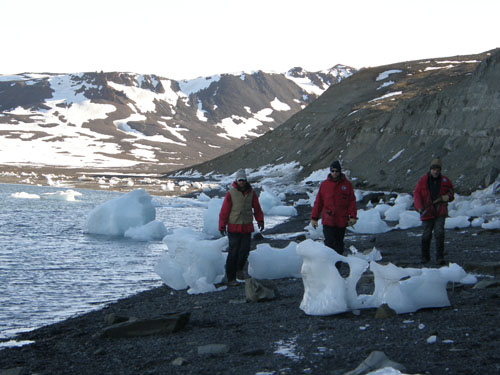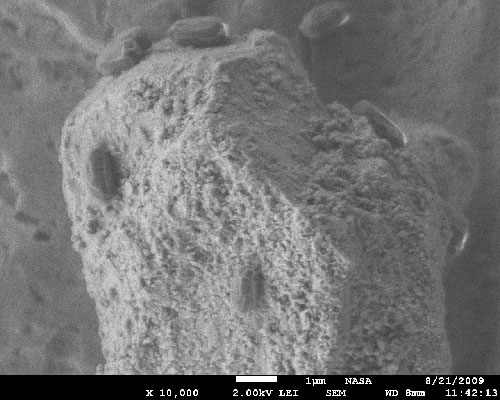In this research area, UWAB faculty and students explore the evolutionary processes and survival mechanisms of organisms that live in extreme environments on our planet. These “extremophiles” populate habitats like deep-sea hydrothermal vents, Arctic sea ice, geothermal hot springs, and extremely dry desert soils. These environments and their inhabitants give us a glimpse into potentially habitable environments on other planetary bodies, where these extreme conditions might be more common.
Hydrothermal Vents
 In the depths of our oceans, where volcanism brings magma close to the Earth’s crust, we find hydrothermal vent systems. In these regions, water erupts from the seafloor at temperatures up to 400˚C, and there is no sunlight to act as an energy source. Yet these systems are host to diverse ecosystems of worms, clams, mussels, crabs, shrimp, and octopuses. At the base of these ecosystems are microbes called archaea and bacteria. Researchers at the UW are working to understand how the archaea and bacteria at these hydrothermal vents survive and evolve over time. Hydrothermal vents like these might exist on the bottom of Europa’s internal ocean. Moreover, since hydrothermal vents are thought to be ancient systems, these archaea and bacteria may provide insight into how life evolved over three and a half billion years ago.
In the depths of our oceans, where volcanism brings magma close to the Earth’s crust, we find hydrothermal vent systems. In these regions, water erupts from the seafloor at temperatures up to 400˚C, and there is no sunlight to act as an energy source. Yet these systems are host to diverse ecosystems of worms, clams, mussels, crabs, shrimp, and octopuses. At the base of these ecosystems are microbes called archaea and bacteria. Researchers at the UW are working to understand how the archaea and bacteria at these hydrothermal vents survive and evolve over time. Hydrothermal vents like these might exist on the bottom of Europa’s internal ocean. Moreover, since hydrothermal vents are thought to be ancient systems, these archaea and bacteria may provide insight into how life evolved over three and a half billion years ago.
Sea Ice And Frost Flowers
 When sea ice freezes, the salt in the seawater is extruded into brine pockets, which stays liquid for a longer time than the surrounding ice. Above the sea ice, large ice crystals called frost flowers form above young sea ice when conditions are calm and cold. Both the brine pockets in the sea ice and the frost flowers have high salinity and a high concentration of other compounds in ocean water, and any microbes living in these structures are faced with extremely cold temperatures and high salinities. Scientists in the Oceanography department at the UW are studying microbes living in sea ice, and have found ways in which the cells living in these brine pockets can protect against the harsh conditions of low temperature and high salinity. Studying these microbes and the mechanisms they use for surviving these cold temperatures may provide insight into how life might survive on an icy moon like Europa or Enceladus.
When sea ice freezes, the salt in the seawater is extruded into brine pockets, which stays liquid for a longer time than the surrounding ice. Above the sea ice, large ice crystals called frost flowers form above young sea ice when conditions are calm and cold. Both the brine pockets in the sea ice and the frost flowers have high salinity and a high concentration of other compounds in ocean water, and any microbes living in these structures are faced with extremely cold temperatures and high salinities. Scientists in the Oceanography department at the UW are studying microbes living in sea ice, and have found ways in which the cells living in these brine pockets can protect against the harsh conditions of low temperature and high salinity. Studying these microbes and the mechanisms they use for surviving these cold temperatures may provide insight into how life might survive on an icy moon like Europa or Enceladus.
Antarctic Lakes
 Below the Antarctic glaciers lie lakes that have been sealed from the atmosphere for millions of years. Organisms that live in these lakes must cope with low nutrient and energy levels, and extremely low temperatures. Researchers at the UW are working to explore these lakes to understand how such organisms might make their living, and how these lakes might be good analogs for environments on icy moons such as Europa or Enceladus.
Below the Antarctic glaciers lie lakes that have been sealed from the atmosphere for millions of years. Organisms that live in these lakes must cope with low nutrient and energy levels, and extremely low temperatures. Researchers at the UW are working to explore these lakes to understand how such organisms might make their living, and how these lakes might be good analogs for environments on icy moons such as Europa or Enceladus.
Microbes In The Atmosphere
 Microbes like bacteria and fungi can sometimes get injected into the upper atmosphere by dust storms and other weather conditions, and then blown across the globe for long distances. These microbes must survive extreme cold, dehydration, and high radiation, along with low nutrient and energy availability. Scientists are working to understand what types of microbes are found in the upper atmosphere, and how they manage to survive such harsh conditions. Studying the ways these microbes survive in the upper atmosphere may provide insights into how microbes get transported across a planet, and whether they could hitch a ride on meteorites or on spacecraft like the Mars Rover.
Microbes like bacteria and fungi can sometimes get injected into the upper atmosphere by dust storms and other weather conditions, and then blown across the globe for long distances. These microbes must survive extreme cold, dehydration, and high radiation, along with low nutrient and energy availability. Scientists are working to understand what types of microbes are found in the upper atmosphere, and how they manage to survive such harsh conditions. Studying the ways these microbes survive in the upper atmosphere may provide insights into how microbes get transported across a planet, and whether they could hitch a ride on meteorites or on spacecraft like the Mars Rover.
